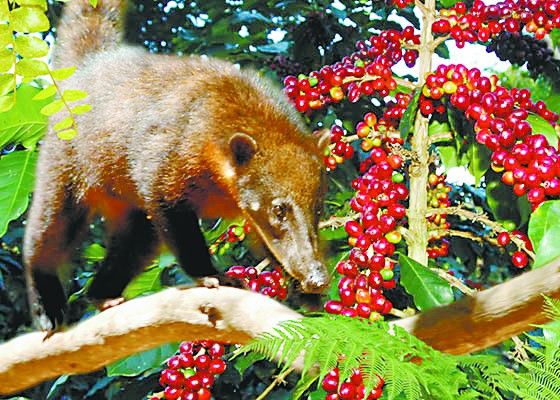Peruvian raccoon shit coffee is the most expensive $60 a cup in the world.

Peruvian coffee has been very popular in the international market in recent years, frequently winning international coffee gold medals. Peruvian coffee is very popular for its mellow taste and soft acidity. Peru has become the world's third-largest coffee exporter, especially a coffee derived from raccoon droppings, which costs tens of dollars a cup and is among the most expensive coffee in the world.
Raccoon poop, coffee, expensive.
Reporters in Lima, Peru, a small coffee shop, to see to buy coffee, coffee drinkers stream. On the shelves are cans of coffee from different parts of Peru. The reporter found that a coffee called raccoon is ridiculously expensive, 10 times the price of other varieties of coffee, about more than $150 a kilogram. Ask the boss, it turns out that this is a kind of coffee processed from animal feces, it is mainly produced in the Peruvian Amazon area, is made of coffee beans eaten by raccoons, digested and excreted, this coffee beans after cleaning and roasting processing, to form this pure natural raccoon feces coffee (as shown in the picture).
This coffee produces less than 2000 kilograms a year, most of which are exported to the United States, with an annual export of more than 1400 kilograms. In the United States, a cup costs 60 dollars, and a kilogram costs as much as 1400 dollars. Even a small cup of coffee in a coffee shop in Peru costs more than ten dollars, making it the most expensive coffee in the world.
The reporter tasted the raccoon feces coffee and chose the American production method. In this way, the coffee taste will be pure. The first taste of coffee is very strong, slightly bitter, added some sugar, and the taste becomes softer. After drinking, the coffee aroma lasts for a long time. A nearby woman buying coffee beans told me that it tastes better with alcohol--maybe everyone likes it differently.
Raccoon is a coffee factory.
The reason why this premium coffee from the Peruvian Amazon region has become the most expensive and delicious coffee is inseparable from a long-billed raccoon unique to South America that lives at an altitude of 1800 meters to more than 4000 meters. The raccoon is small, about the size of a house cat, and has a long mouth. Raccoons like to eat fresh and fragrant fruits very much. After raccoons carefully select and eat ripe and fresh coffee fruits, the coffee peel and meat are digested through its stomach. Coffee beans cannot be digested and fermented in raccoons 'stomach, resulting in the destruction of protein in coffee beans, thus reducing the bitter taste of coffee beans. After being expelled from the body, after artificial cleaning and roasting, the coffee produced has a special taste and becomes a hot commodity in the international market. It is unique in that a series of processes such as peeling coffee fruits processed by machines are magically completed in the raccoon stomach after 4 to 6 hours! Absolutely natural.
In addition, long-billed raccoons can only eat 25 grams of fresh coffee a day, and they choose especially fresh, full and delicious coffee to eat, so this coffee production is very small, forming a unique premium coffee with high added value, so the price is ridiculously high.
Citizens are encouraged to drink more coffee
Coffee has become Peru's main agricultural earner in recent years. But coffee cultivation in Peru is still very decentralized, primitive and small-scale family farming. At the same time, coffee consumption in Peru differs significantly from that of South American countries such as Colombia and Brazil.
According to statistics, Colombia and Brazil consume 2.5 kg and 6 kg of coffee per capita per year, while Peru consumes only 500 grams per capita per year. To this end, Peru's Ministry of Agriculture passed legislation in 2008 to establish August 28 as Peru's "Coffee Festival" to promote coffee cultivation and consumption in Peru. In recent years, Peruvian media have also vigorously promoted the benefits of coffee to human health, introducing coffee to reduce the risk of cancer, liver disease and the prevention, mitigation and treatment of other diseases, encouraging Peruvians to drink more coffee and enhance physical fitness.
Peru has a climate and other natural conditions suitable for coffee cultivation, including tropical rain forests, long Andes mountains, unique hills and dry deserts. Coffee growing areas are distributed in the eastern Andes mountains at an altitude of 1300 meters to 2000 meters zone.
Peruvian coffee has three main producing areas: Cajamarca in the north, San Martin and Amazonia. In the south are the provinces of Ayacucho, Puno and Cuzco. Peruvian coffee can be grown at an altitude of up to 2000 meters. Such high altitude and sunshine on the plateau create the unique flavor of Peruvian coffee. Some media commented on Peruvian coffee: "Peruvian coffee has created another style in South America that Brazil and Colombia do not have." In particular, the specialty organic coffee produced in Peru is famous all over the world.
Because of the government's encouragement of coffee cultivation, coupled with the fact that Peru has many suitable areas for coffee cultivation and the growing area, Peru has several areas that are internationally known for their quality coffee production.
Important Notice :
前街咖啡 FrontStreet Coffee has moved to new addredd:
FrontStreet Coffee Address: 315,Donghua East Road,GuangZhou
Tel:020 38364473
- Prev

Wine and coffee are more likely to get drunk.
For people born in the 1970s, Teresa Teng is probably an eternal legend. Many of her songs once pervaded the streets. For example, the song "Wine and Coffee": neither Teresa Teng nor the author of this song would have thought that this song actually describes a scientific fact: when drinking wine and coffee together, drink cup after cup before you know it.
- Next

Coffee health drinking coffee alone can not reach the carcinogenic amount.
A few days ago, an article entitled "you can't drink instant coffee, there are more carcinogens than smoking" spread on the Internet. The article says instant coffee is highly carcinogenic and contains higher concentrations of acrylamide than cakes, French fries, potato chips and cigarettes. Nguyen Guangfeng, an expert at the Food and Nutrition Information Center, said that this statement is a typical logical trap, and there is no food in the world.
Related
- Beginners will see the "Coffee pull flower" guide!
- What is the difference between ice blog purified milk and ordinary milk coffee?
- Why is the Philippines the largest producer of crops in Liberia?
- For coffee extraction, should the fine powder be retained?
- How does extracted espresso fill pressed powder? How much strength does it take to press the powder?
- How to make jasmine cold extract coffee? Is the jasmine + latte good?
- Will this little toy really make the coffee taste better? How does Lily Drip affect coffee extraction?
- Will the action of slapping the filter cup also affect coffee extraction?
- What's the difference between powder-to-water ratio and powder-to-liquid ratio?
- What is the Ethiopian local species? What does it have to do with Heirloom native species?

